Facile Preparation of Polysiloxane-Modified Asphalt Binder Exhibiting Enhanced Performance
Abstract
:1. Introduction
2. Materials and Methods
2.1. Materials
2.2. Preparation of HO-PDMS-Modified Asphalt
2.3. Test Methods
2.3.1. FT-IR
2.3.2. 1H-NMR
2.3.3. GPC
2.3.4. FM
2.3.5. Segregation Test
2.3.6. DSC
2.3.7. Physical Property Tests
2.3.8. DSR
2.3.9. BBR
2.3.10. TGA
2.3.11. Static Contact Angle Measurement
3. Results and Discussion
3.1. Interaction Mechanism of HO-PDMS in Base Asphalt
3.2. Compatibility of HO-PDMS with Asphalt
3.3. Low-Temperature Property
3.4. Physical Properties
3.5. Rheological Properties
3.5.1. High-Temperature Rheological Property
3.5.2. Low-Temperature Rheological Property
3.6. Thermal Stability
3.7. Surface Property
4. Conclusions
Author Contributions
Funding
Data Availability Statement
Conflicts of Interest
References
- Debbarma, K.; Debnath, B.; Sarkar, P.P. A comprehensive review on the usage of nanomaterials in asphalt mixes. Constr. Build. Mater. 2022, 361, 129634. [Google Scholar] [CrossRef]
- Duarte, G.M.; Faxina, A.L. Asphalt concrete mixtures modified with polymeric waste by the wet and dry processes: A literature review. Constr. Build. Mater. 2021, 312, 125408. [Google Scholar] [CrossRef]
- Abed, M.A.; Al-Tameemi, A.F.; Abed, A.H.; Wang, Y. Direct tensile test evaluation and characterization for mechanical and rheological properties of polymer modified hot mix asphalt concrete. Polym. Compos. 2022, 43, 6381–6388. [Google Scholar] [CrossRef]
- Shi, K.; Ma, F.; Liu, J.; Fu, Z.; Song, R.M.; Yuan, D.D.; Li, C. Rejuvenation effect of aged SBS-modified asphalt utilizing molecule analysis. J. Clean. Prod. 2023, 405, 136964. [Google Scholar] [CrossRef]
- Ma, F.; Jin, Y.X.; Fu, Z.; Dai, J.S.; Zhang, P.; Zhang, C.; Wen, Y.L. Influencing factors and evaluation methods of reinforcement effect of fiber-modified asphalt binder. Polym. Compos. 2022, 43, 8986–8999. [Google Scholar] [CrossRef]
- Gallu, R.; Méchin, F.; Dalmas, F.; Gérard, J.; Perrin, R.; Loup, F. Rheology-morphology relationships of new polymer-modified bitumen based on thermoplastic polyurethanes (TPU). Constr. Build. Mater. 2020, 259, 120404. [Google Scholar] [CrossRef]
- Wang, W.; Li, X.S.; Shen, J.A.; Yuan, F.G. Low temperature ductility of BA-VAc olefin polymer modified asphalt binders. Constr. Build. Mater. 2023, 373, 130728. [Google Scholar] [CrossRef]
- Tan, Y.Q.; Zhang, J.J.; Zou, G.L.; Qin, H. Aging characterization of rheology and morphology evolution of SBS-modified asphalt. Constr. Build. Mater. 2022, 342, 128027. [Google Scholar] [CrossRef]
- Han, Y.J.; Cui, B.Y.; Tian, J.H.; Ding, J.T.; Ni, F.J.; Lu, D.H. Evaluating the effects of styrene-butadiene rubber (SBR) and polyphosphoric acid (PPA) on asphalt adhesion performance. Constr. Build. Mater. 2022, 321, 126028. [Google Scholar] [CrossRef]
- Li, F.; Zhang, X.; Wang, L.B.; Zhai, R.X. The preparation process, service performances and interaction mechanisms of crumb rubber modified asphalt (CRMA) by wet process: A comprehensive review. Constr. Build. Mater. 2022, 354, 129168. [Google Scholar] [CrossRef]
- Du, Z.Y.; Jiang, C.S.; Yuan, J.; Xiao, F.P.; Wang, J.G. Low temperature performance characteristics of polyethylene modified asphalts-A review. Constr. Build. Mater. 2020, 264, 120704. [Google Scholar] [CrossRef]
- Joohari, I.B.; Giustozzi, F. Effect of different vinyl-acetate contents in hybrid SBS-EVA modified bitumen. Constr. Build. Mater. 2020, 262, 120574. [Google Scholar] [CrossRef]
- Yang, S.G.; Ji, J.Q.; Tao, H.; Muhammad, Y.; Huang, J.X.; Wang, S.S.; Wei, Y.H.; Li, J. Fabrication of urea formaldehyde-epoxy resin microcapsules for the preparation of high self-healing ability containing SBS modified asphalt. Polym. Compos. 2021, 42, 4128–4137. [Google Scholar] [CrossRef]
- Kok, B.V.; Yalcin, B.F.; Yilmaz, M.; Yalcin, E. Performance evaluation of bitumen modified with styrene-isoprene-styrene and crumb rubber compound. Constr. Build. Mater. 2022, 344, 128304. [Google Scholar] [CrossRef]
- Dong, F.Q.; Yang, P.X.; Yu, X.; Jiang, M.M.; Wang, S.Y.; Zu, Y.Z.; Chen, B.; Wang, J.C. Morphology, chemical reaction mechanism, and cross-linking degree of asphalt binder modified by SBS block co-polymer. Constr. Build. Mater. 2023, 378, 131204. [Google Scholar] [CrossRef]
- Mariani, S.; Mattina, A.A.L.; Paghi, A.; Strambini, L.; Barillaro, G. Maskless preparation of spatially-resolved plasmonic nanoparticles on polydimethylsiloxane via in situ fluoride-assisted synthesis. Adv. Funct. Mater. 2021, 31, 2100774. [Google Scholar] [CrossRef]
- Zhang, Z.X.; Song, X.J.; Li, Y.R.; Chen, X.G.; Zhang, Y.; Lv, H.P.; Tang, Y.Y.; Xiong, R.G.; Zhang, H.Y. The first chiro-inositol organosilicon ferroelectric crystal. Angew. Chem. 2022, 61, e202210809. [Google Scholar] [CrossRef] [PubMed]
- McVerry, B.; Polasko, A.; Rao, E.; Haghniaz, R.; Chen, D.Y.; He, N.; Ramos, P.; Hayashi, J.; Curson, P.; Wu, C.Y.; et al. A readily scalable, clinically demonstrated, antibiofouling zwitterionic surface treatment for implantable medical devices. Adv. Mater. 2022, 34, 2200254. [Google Scholar] [CrossRef]
- Sanderson, F.C. Methyl-chlorosilanes as anti-stripping agents. In Highway Research Board Proceedings; Transportation Research Bord: Washington, DC, USA, 1952; Volume 31, pp. 288–300. [Google Scholar]
- Schmidt, R.J.; Cerrito, E.; Graf, P.E. Asphalt Mineral Aggregate Compositions Containing Silanes as Adhesion Promoters. U.S. Patent US04036661A, 19 July 1977. [Google Scholar]
- Lou, K.; Xiao, P.; Tang, Q.; Wu, Y.H.; Wu, Z.G.; Pan, X.H. Research on the micro-nano characteristic of basalt fiber and its impact on the performance of relevant asphalt mastic. Constr. Build. Mater. 2022, 318, 126048. [Google Scholar] [CrossRef]
- Liu, Q.; Chen, S.; He, X.Y.; Su, Y.; Zeng, J.Y.; Zhu, Y.; Pan, Y.Y.; Zhang, B.; Xu, H.; Wu, Y. Surface modification of fly ash by waste engine oil under mechanical activation enhanced the sustainable service life of asphalt. J. Clean. Prod. 2023, 404, 136785. [Google Scholar] [CrossRef]
- Han, X.B.; Yu, J.Y.; Cao, Z.L.; Wang, R.Y.; Du, W.; He, P.; Ge, Y.Y. Preparation and properties of silane coupling agent modified zeolite as warm mix additive. Constr. Build. Mater. 2020, 244, 118408–118417. [Google Scholar] [CrossRef]
- Chen, Z.W.; Gong, Z.L.; Jiao, Y.Y.; Wang, Y.W.; Shi, K.; Wu, J.C. Moisture stability improvement of asphalt mixture considering the surface characteristics of steel slag coarse aggregate. Constr. Build. Mater. 2020, 251, 118987–118997. [Google Scholar] [CrossRef]
- Lv, Y.; Wu, S.P.; Cui, P.D.; Liu, Q.T.; Li, Y.Y.; Xu, H.Q.; Zhao, Y.C. Environmental and feasible analysis of recycling steel slag as aggregate treated by silicone resin. Constr. Build. Mater. 2021, 299, 123914. [Google Scholar] [CrossRef]
- Chen, Z.W.; Wu, S.P.; Xiao, Y.; Zeng, W.B.; Yi, M.W.; Wan, J.M. Effect of hydration and silicone resin on basic oxygen furnace slag and its asphalt mixture. J. Clean Prod. 2016, 112, 392–400. [Google Scholar] [CrossRef]
- Yao, H.; You, Z.P.; Li, L.; Shi, X.M.; Goh, S.W.; Mills-Beale, J.; Wingard, D. Performance of asphalt binder blended with non-modified and polymer-modified nanoclay. Constr. Build. Mater. 2012, 35, 159–170. [Google Scholar] [CrossRef]
- Lushinga, N.; Cao, L.P.; Dong, Z.J.; Yang, C.; Assogba, C. Improving storage stability and physicochemical performance of Styrene-Butadiene-Styrene asphalt binder modified with nanosilica. Sustainability. 2020, 12, 8968. [Google Scholar] [CrossRef]
- Lushinga, N.; Cao, L.P.; Dong, Z.J.; Yang, C.; Assogba, C. Performance evaluation of crumb rubber asphalt modified with Silicone-Based warm mix additives. Adv. Civ. Eng. 2020, 17, 4840825. [Google Scholar] [CrossRef]
- Hou, X.D.; Lv, S.T.; Chen, Z.; Xiao, F.P. Applications of fourier transform infrared spectroscopy technologies on asphalt materials. Measurement 2018, 121, 304–316. [Google Scholar] [CrossRef]
- Zhang, S.; Hong, H.K.; Zhang, H.L.; Chen, Z.H. Investigation of anti-aging mechanism of multi-dimensional nanomaterials modified asphalt by FTIR, NMR and GPC. Constr. Build. Mater. 2021, 305, 124809. [Google Scholar] [CrossRef]
- Zhan, L.X.; Chen, H.; Zhou, H.; Chen, J.W.; Wu, H.; Yang, L.J. Droplet-particle collision dynamics: A molecular dynamics simulation. Powder Technol. 2023, 422, 118456. [Google Scholar] [CrossRef]
- Dong, F.Y.; Diao, S.; Ma, D.P.; Zhang, S.Y.; Feng, S.Y. Preparation and characterization of 3-chloropropyl polysiloxane-based heat-curable silicone rubber using polyamidoamine dendrimers as cross-linkers. React. Funct. Polym. 2015, 96, 14–20. [Google Scholar] [CrossRef]
- Stern, S.A.; Shah, V.M.; Hardy, B.J. Structure-permeability relationships in silicone polymers. J. Polym. Sci. Part B Polym. Phys. 1987, 25, 1263–1298. [Google Scholar] [CrossRef]
- Pandiyarajan, C.K.; Genzer, J. Thermally activated one-pot, simultaneous radical and condensation reactions generate surface-anchored network layers from common polymers. Macromolecules 2019, 52, 700–707. [Google Scholar] [CrossRef]
- Chen, R.Z.; Xie, Q.Y.; Zeng, H.H.; Ma, C.F.; Zhang, G.Z. Non-elastic glassy coating with fouling release and resistance abilities. J. Mater. Chem. A. 2020, 8, 380–387. [Google Scholar] [CrossRef]
- Liu, T.; Guo, N.S.; Jin, X.; Tan, Y.Q.; You, Z.P.; Cui, S.C.; Chu, Z.Y.; Fang, C.C. Thermoregulation, rheological properties and modification mechanism of asphalt modified with PUSSPCMs. Constr. Build. Mater. 2023, 372, 130763. [Google Scholar] [CrossRef]
- Aflaki, S.; Hajikarimi, P. Implementing viscoelastic rheological methods to evaluate low temperature performance of modified asphalt binders. Constr. Build. Mater. 2012, 36, 110–118. [Google Scholar] [CrossRef]
- David, J.; Christopher, D.; Daniel, J. Applying the glover-rowe parameter to evaluate low-temperature performance of hot mix asphalt LTPP sections. J. Mater. Civ. Eng. 2016, 28, 10. [Google Scholar] [CrossRef]
- Kuciński, K.; Stachowiak-Dłużyńska, H.; Hreczycho, G. Catalytic silylation of O-nucleophiles via Si-H or Si-C bond cleavage: A route to silyl ethers, silanols and siloxanes. Coord. Chem. Rev. 2022, 459, 214456. [Google Scholar] [CrossRef]
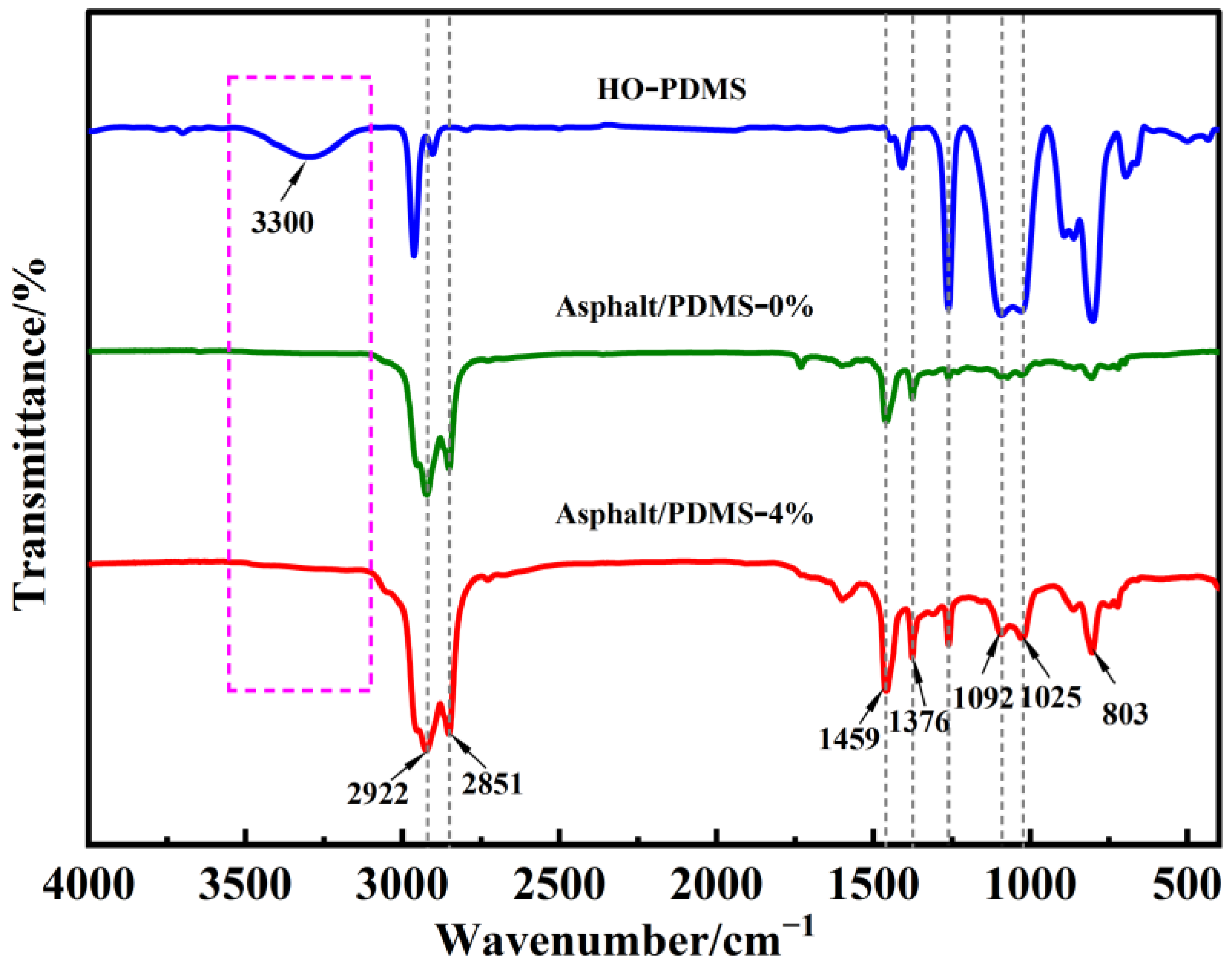
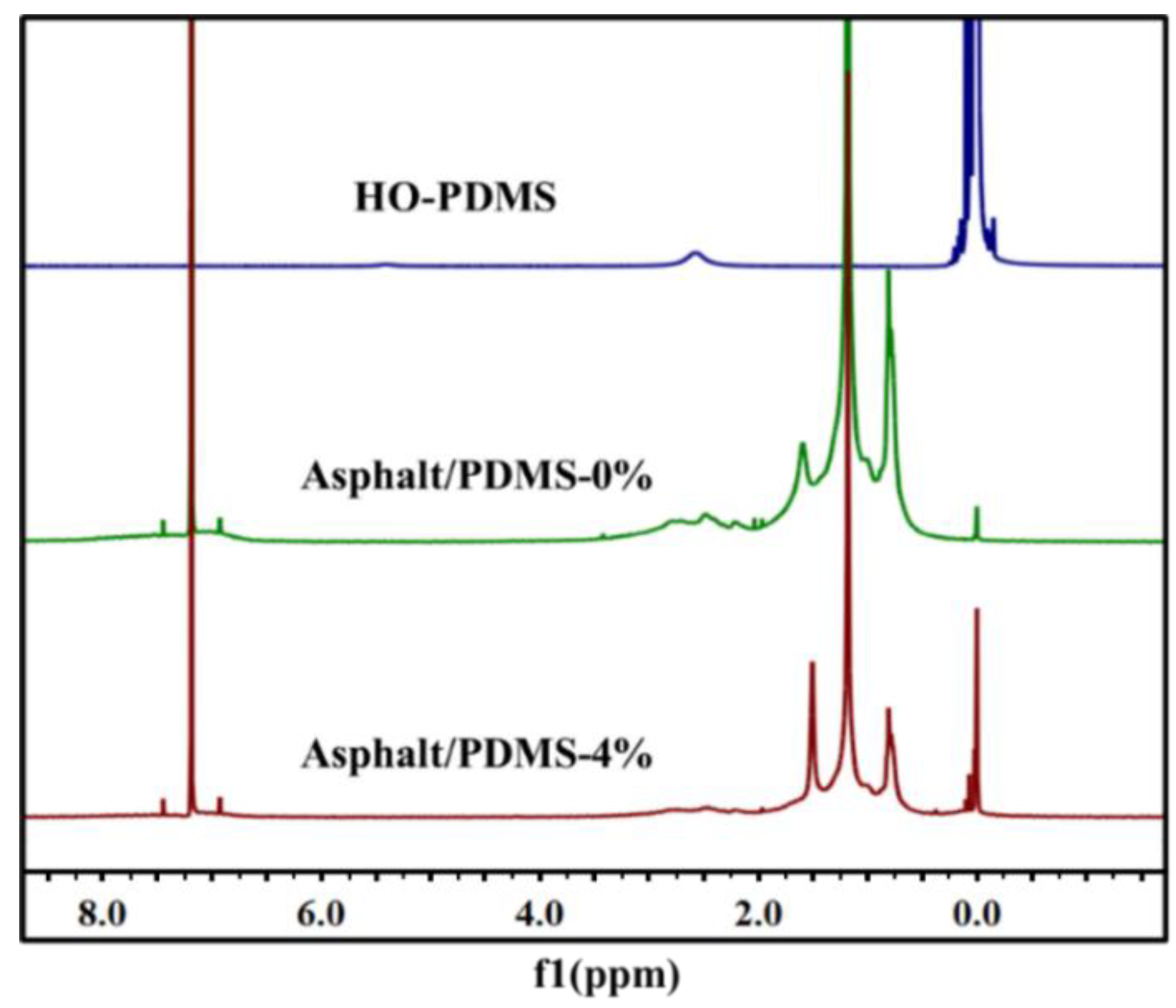
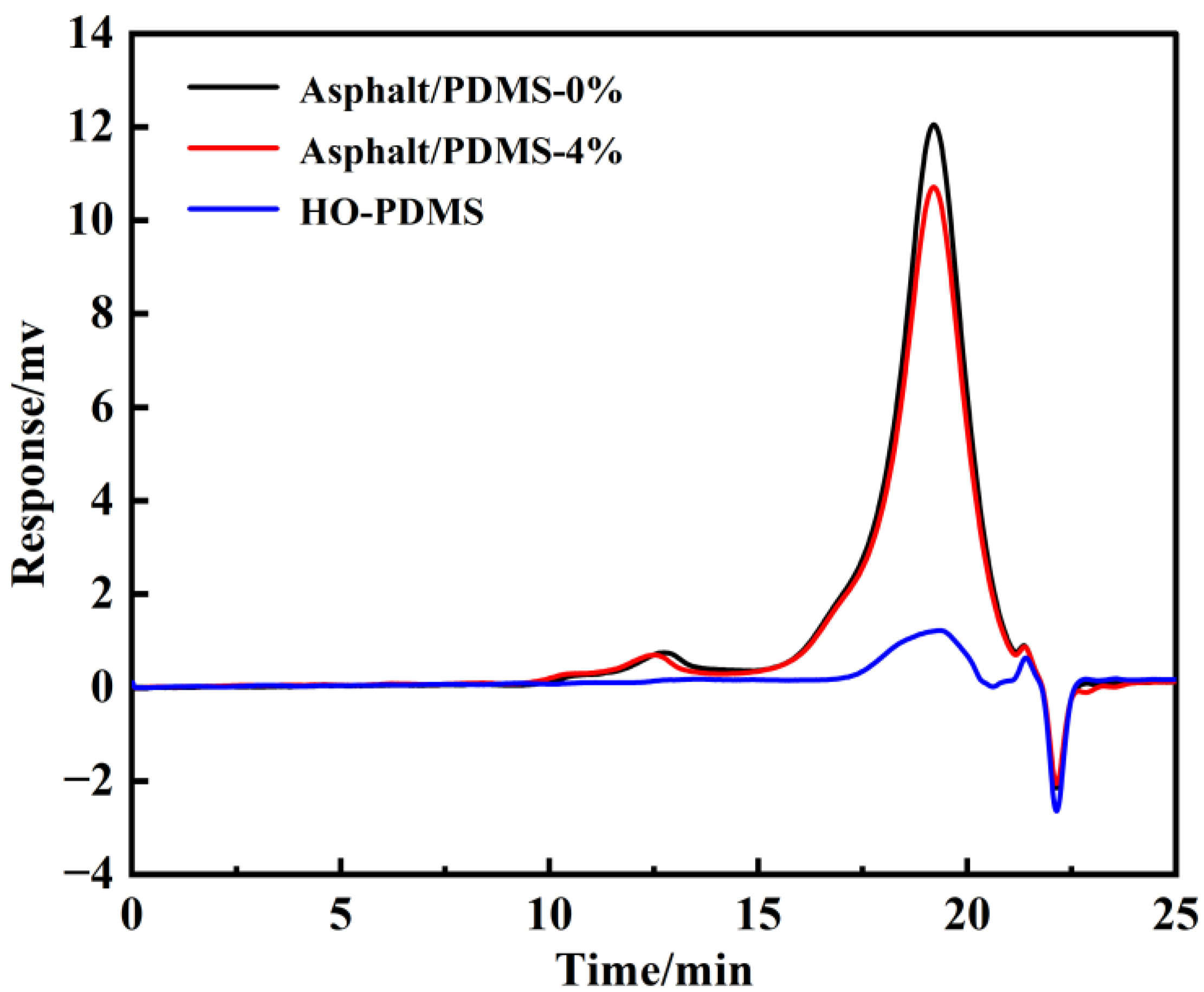

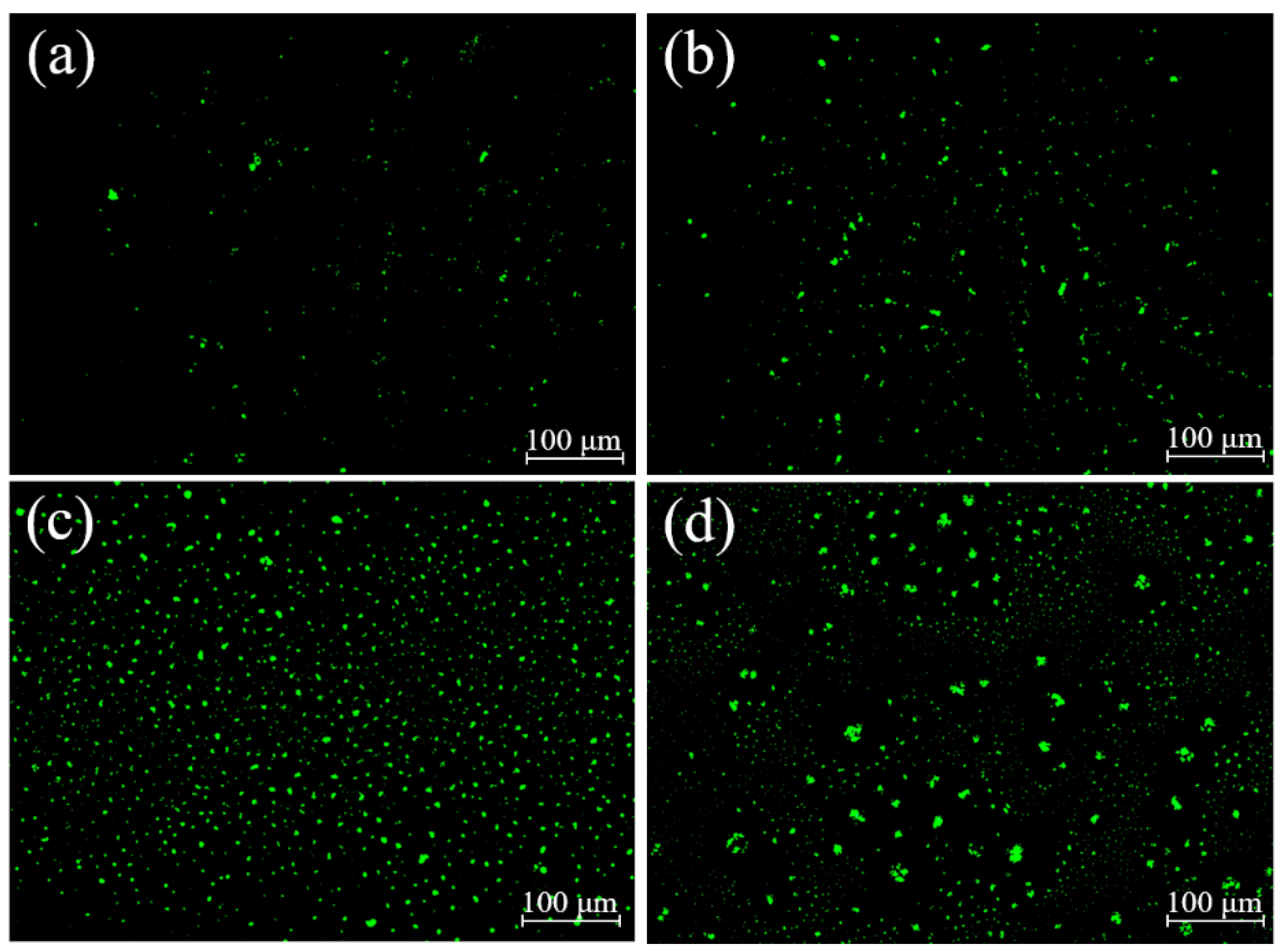
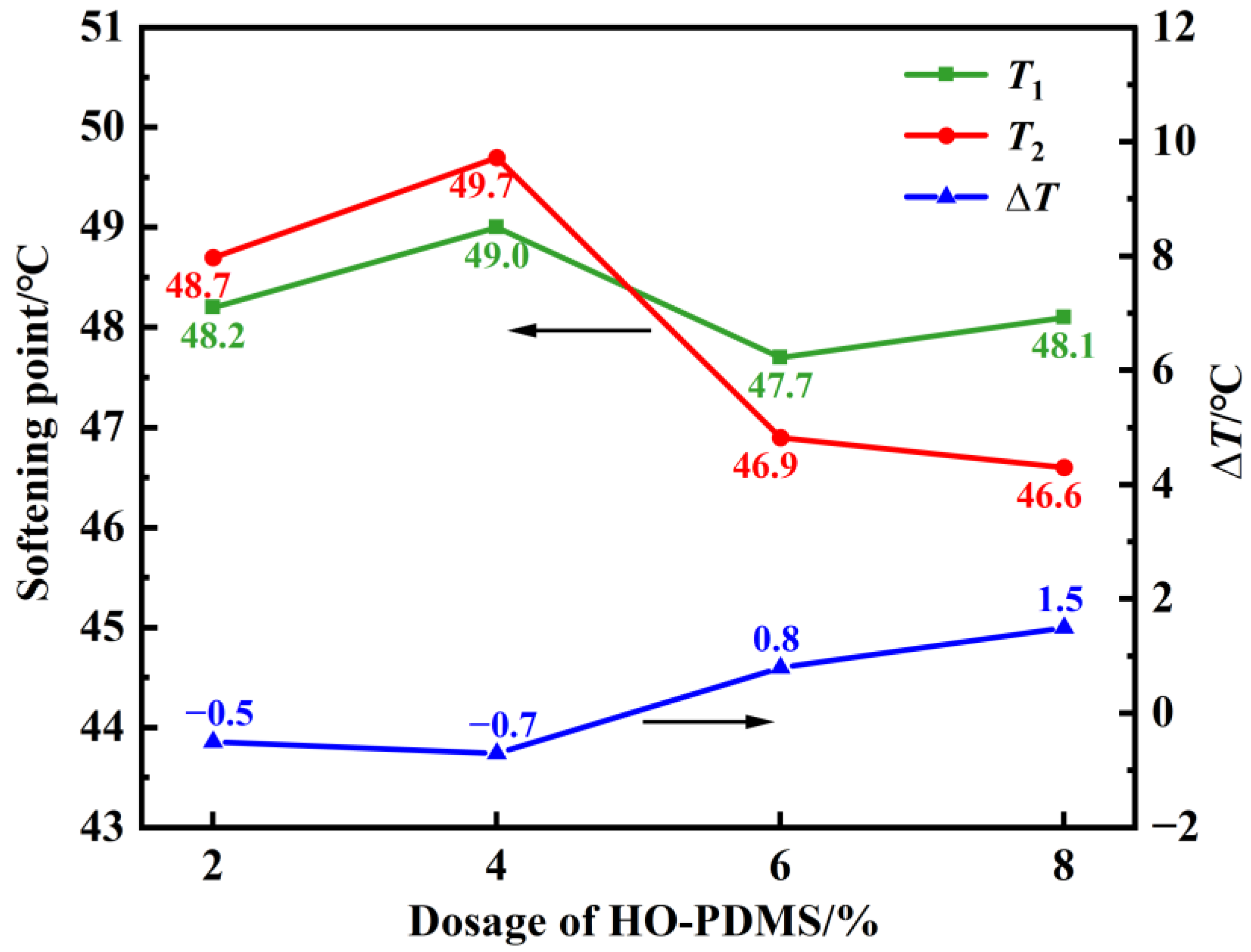
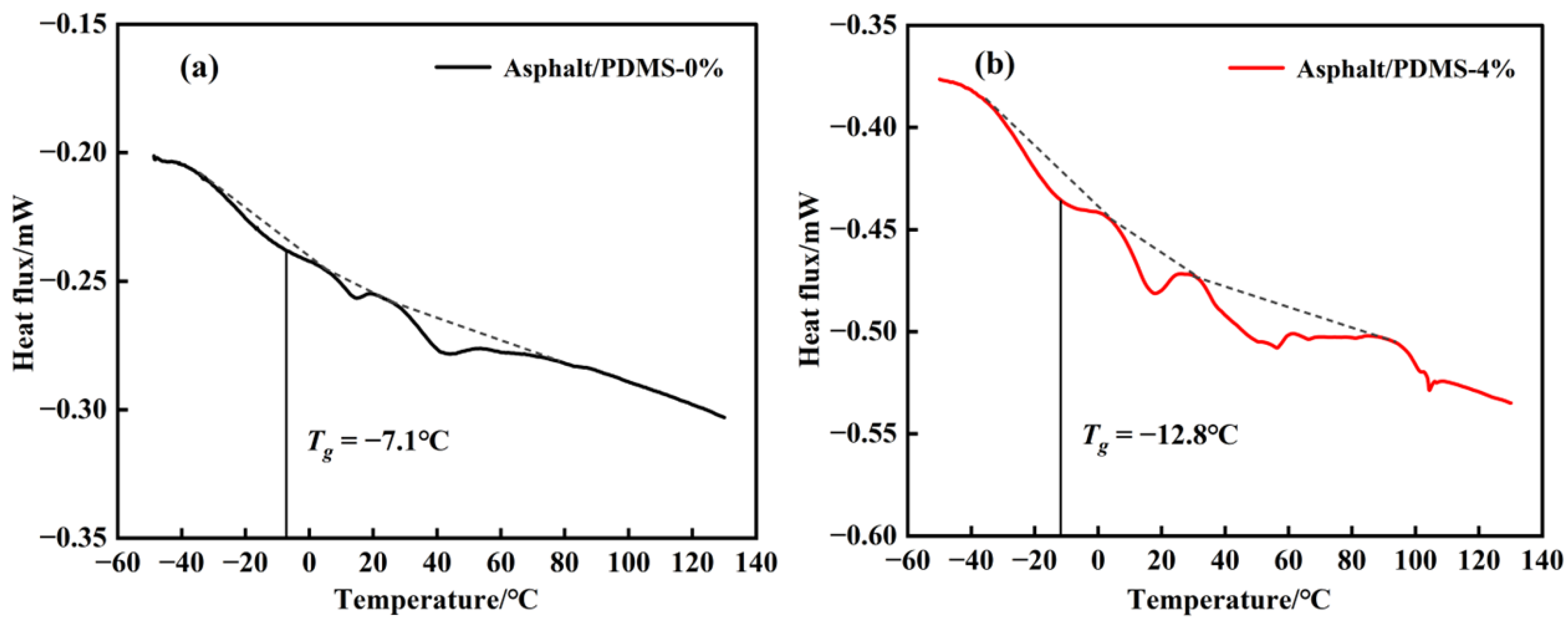
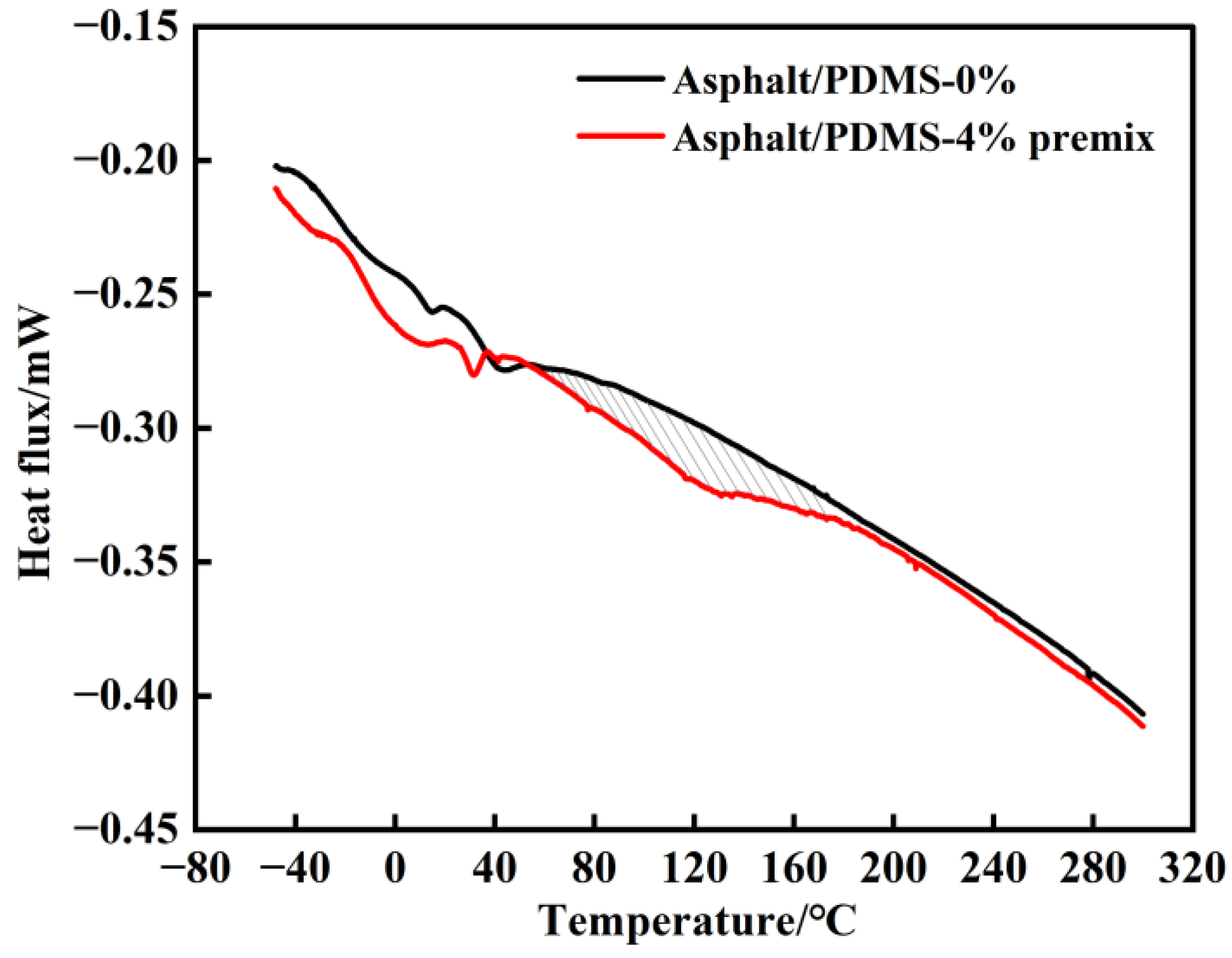
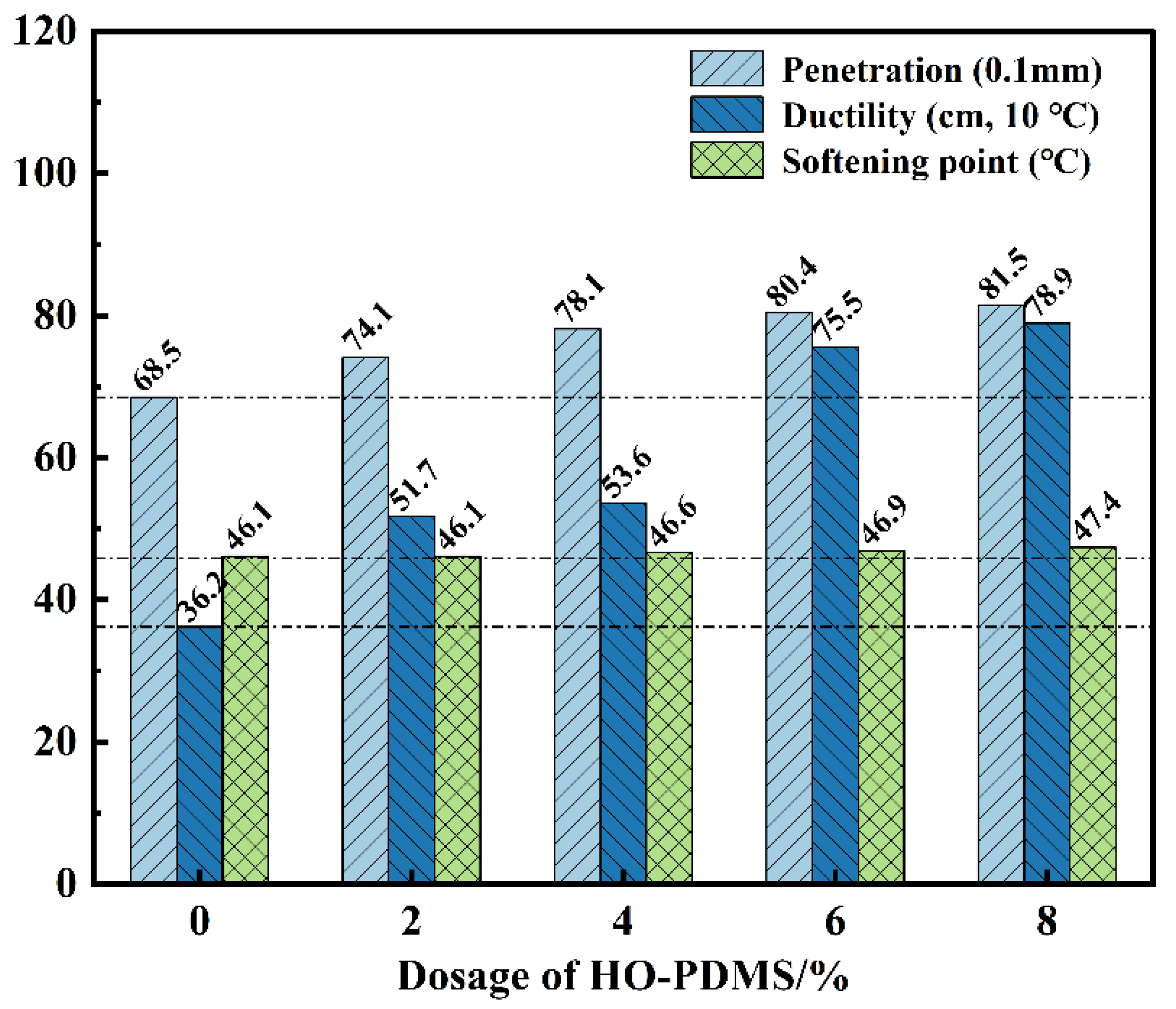

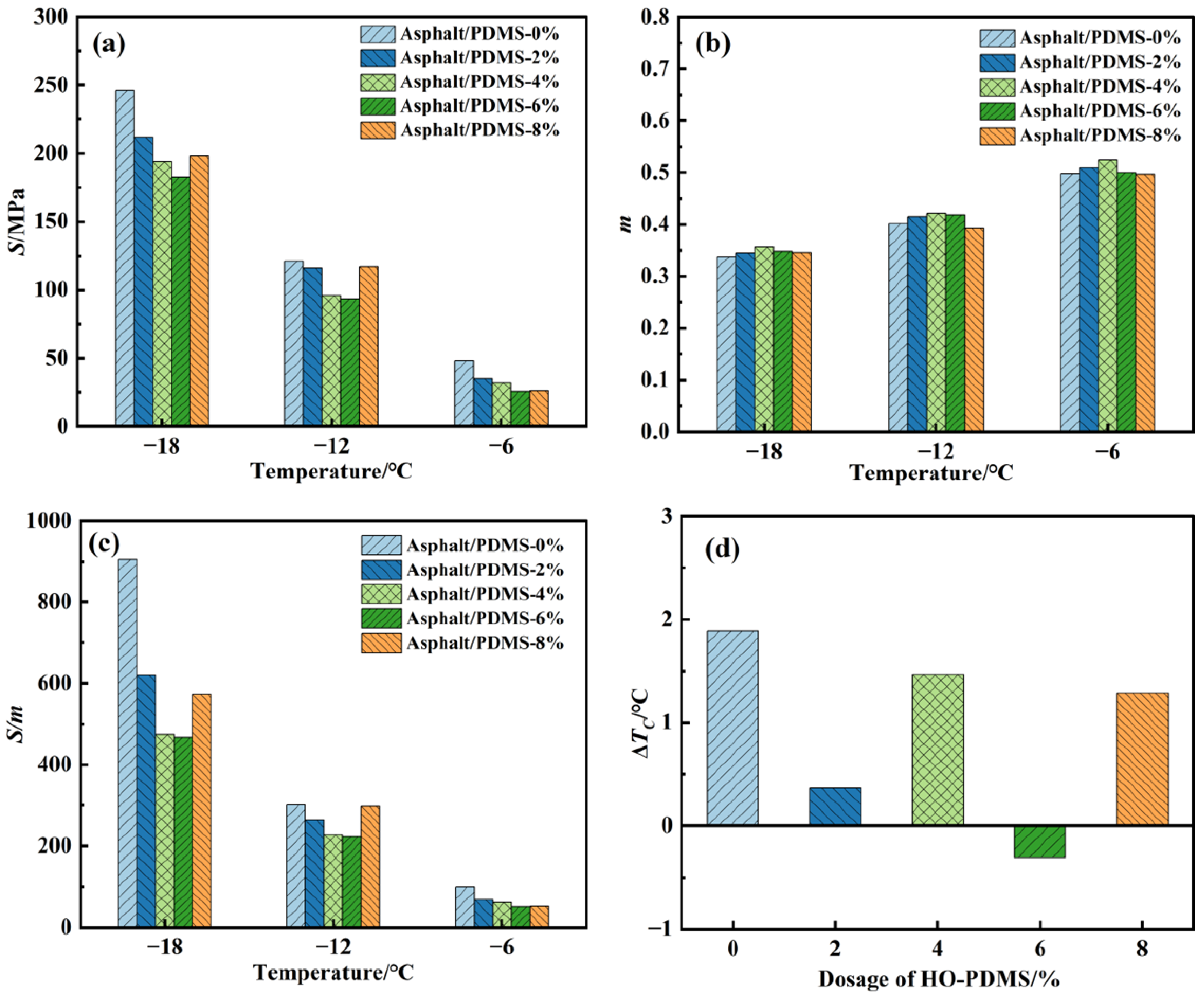

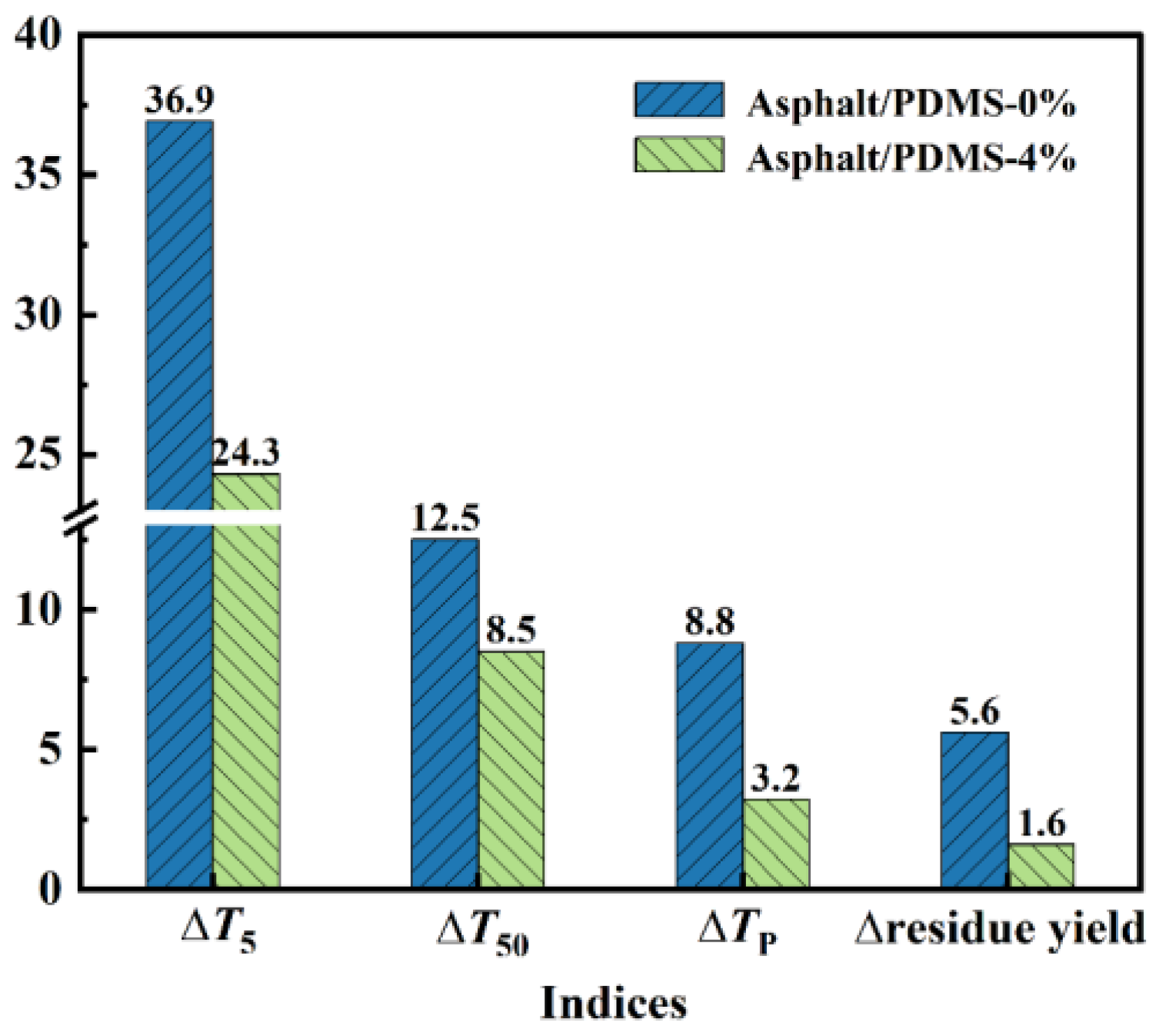
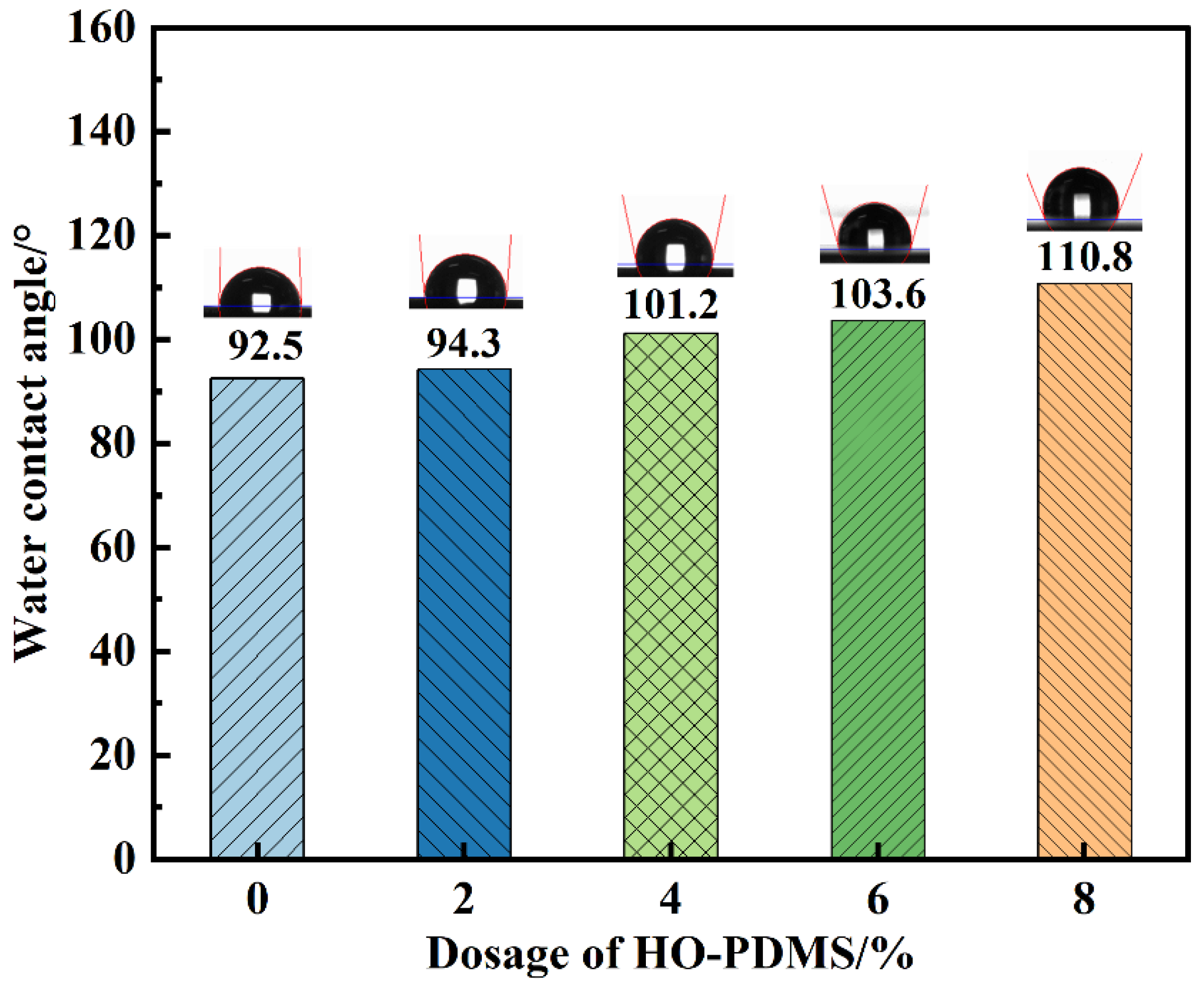
| Indices | Result | Technical Requirement | Test Standard |
|---|---|---|---|
| Penetration (25 °C, 100 g, 5 s), 0.1 mm | 68.5 | 60–80 | ASTM D5 |
| Ductility (10 °C, 5 cm/min), cm | 36.2 | ≥20 | ASTM D113 |
| Softening point, °C | 46.1 | ≥46 | ASTM D36 |
| Sample | Base Asphalt/g | HO-PDMS/g |
|---|---|---|
| Asphalt/PDMS-0% | 100 | 0 |
| Asphalt/PDMS-2% | 100 | 2 |
| Asphalt/PDMS-4% | 100 | 4 |
| Asphalt/PDMS-6% | 100 | 6 |
| Asphalt/PDMS-8% | 100 | 8 |
| Sample | Mn/g·mol−1 | Mw/g·mol−1 | ||
|---|---|---|---|---|
| Asphalt/PDMS-0% | 194,812 | 1426 | 288,419 | 2909 |
| Asphalt/PDMS-4% | 251,082 | 1435 | 379,093 | 3038 |
| HO-PDMS | - | 1641 | - | 2626 |
| Sample | T5/°C | T50/°C | Tp/°C | Residue Yield/% |
|---|---|---|---|---|
| Asphalt/PDMS-0% (nitrogen) | 374.0 | 460.0 | 458.8 | 17.7 |
| Asphalt/PDMS-4% (nitrogen) | 356.3 | 462.3 | 463.7 | 18.1 |
| Asphalt/PDMS-0% (air) | 337.1 | 447.5 | 450.0 | 12.1 |
| Asphalt/PDMS-4% (air) | 332.0 | 453.9 | 460.5 | 16.5 |
Disclaimer/Publisher’s Note: The statements, opinions and data contained in all publications are solely those of the individual author(s) and contributor(s) and not of MDPI and/or the editor(s). MDPI and/or the editor(s) disclaim responsibility for any injury to people or property resulting from any ideas, methods, instructions or products referred to in the content. |
© 2023 by the authors. Licensee MDPI, Basel, Switzerland. This article is an open access article distributed under the terms and conditions of the Creative Commons Attribution (CC BY) license (https://creativecommons.org/licenses/by/4.0/).
Share and Cite
Qian, J.; Dong, F.; Chen, X.; Xu, X.; Zhang, D.; Li, F.; Gao, Y.; Sun, H.; Pang, L.; Tang, X.; et al. Facile Preparation of Polysiloxane-Modified Asphalt Binder Exhibiting Enhanced Performance. Polymers 2023, 15, 3795. https://doi.org/10.3390/polym15183795
Qian J, Dong F, Chen X, Xu X, Zhang D, Li F, Gao Y, Sun H, Pang L, Tang X, et al. Facile Preparation of Polysiloxane-Modified Asphalt Binder Exhibiting Enhanced Performance. Polymers. 2023; 15(18):3795. https://doi.org/10.3390/polym15183795
Chicago/Turabian StyleQian, Jinhua, Fuying Dong, Xiaohui Chen, Xianying Xu, Dongkang Zhang, Fulong Li, Yuxia Gao, Huadong Sun, Laixue Pang, Xinde Tang, and et al. 2023. "Facile Preparation of Polysiloxane-Modified Asphalt Binder Exhibiting Enhanced Performance" Polymers 15, no. 18: 3795. https://doi.org/10.3390/polym15183795
APA StyleQian, J., Dong, F., Chen, X., Xu, X., Zhang, D., Li, F., Gao, Y., Sun, H., Pang, L., Tang, X., & Wang, D. (2023). Facile Preparation of Polysiloxane-Modified Asphalt Binder Exhibiting Enhanced Performance. Polymers, 15(18), 3795. https://doi.org/10.3390/polym15183795







